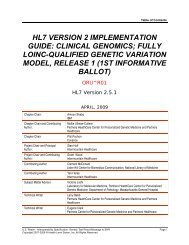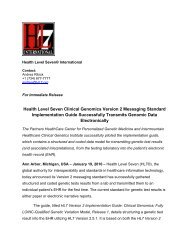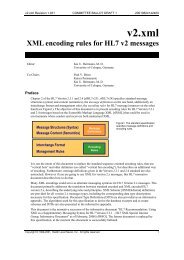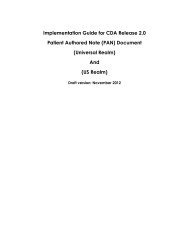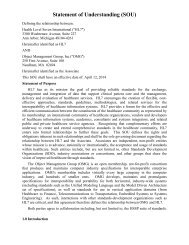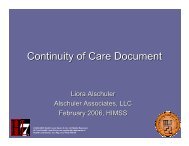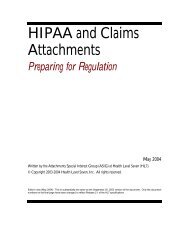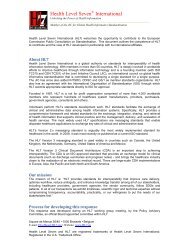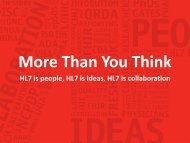HL7 CDA R2 AIS Implementation Guide
HL7 CDA R2 AIS Implementation Guide
HL7 CDA R2 AIS Implementation Guide
Create successful ePaper yourself
Turn your PDF publications into a flip-book with our unique Google optimized e-Paper software.
<strong>HL7</strong> Additional Information Specification <strong>Implementation</strong> <strong>Guide</strong><strong>CDA</strong><strong>R2</strong><strong>AIS</strong>0000R030intentional acts, the participations in those acts, the role that a participant plays, and the entities(persons, organizations, locations or substances) taking on those roles. The type of class used torepresent the information appears in the <strong>AIS</strong> value tables for each attachment component andattachment component answer part. An example and explanation of the value tables and theirstructure can be found in section 2.9 of this implementation guide.Compliance statements and other details about the entry classes are found in section 3.6 and itssub-sections.2.5.4.1.1 ActsMost of the information requested by an <strong>AIS</strong> will appear in some form of act class, representedusing the , , , , or elements, corresponding to ACT, PROC, ENC, OBS, SBADM, or SPLY values in the<strong>AIS</strong> data tables.2.5.4.1.2 Persons and OrganizationsInformation about persons and organizations will be through the participation class, and will beindicated by the value PART in the <strong>AIS</strong> data table. <strong>CDA</strong> uses the following participationelements to represent the participation of various people or organizations: , ,, , , , , ,, , , , ,and . Answer parts will appear in the appropriate participation element, orone of its contained classes based on the kind of information being requested.Each participant has an associated role. For example, the participant has a role. The participation element will often carry the time that participation started in the element, and may include other information, relevant to the participation (e.g., a signaturecode).The role carries the identifiers of the person or organization in one or more contained elements. Addresses and contact information for persons are stored on the role, because thiscontact information may vary with the role.Each role has an at least one associated entity, which may be a person or organization, or both,depending upon the type of role. For example, the role can have an entity, as well as a entity.Entities carry the names of people or organizations. Enties representing organizations also carrythe address and contact information for the organization.2.5.4.1.3 SubstancesActs related to substances ( and ) have other participants,which are the substances being administered (through the element), or supplied(via the element). The product is acting in the role, and thesubstance detail appears mainly in the entities represented by the or elements.Copyright © 1998-2007 Health Level Seven, Inc. All rights reserved.Release 3.0 Draft StandardPage 25March 2007




